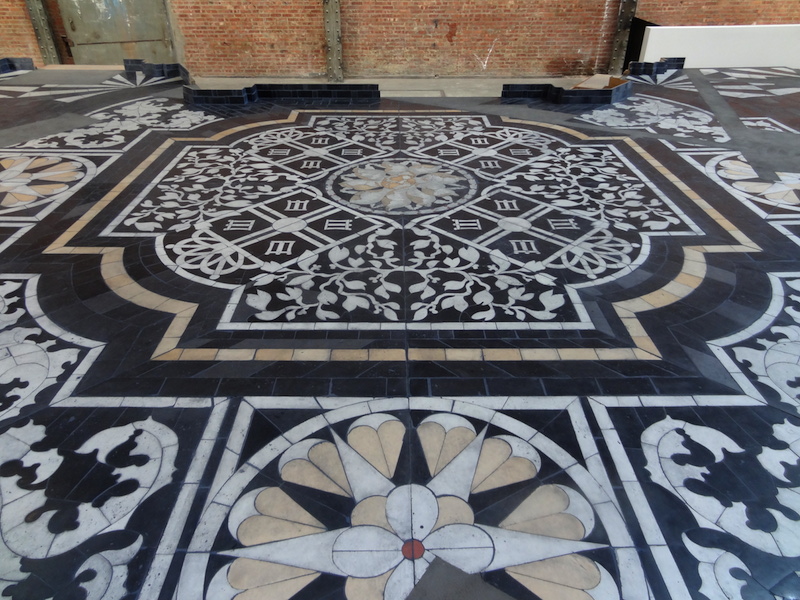
Photo: Benjamin Sutton.
The renowned Icelandic conceptual sculptor Katrín Sigurdardóttir has brought an 18th-century palazzo to a former trolley repair warehouse in Queens. Or, to be exact, she has filled SculptureCenter’s soaring central gallery with an installation that manages to be both grand and understated: A fictional pavilion’s ornately tiled floor. While the artist’s stated intent is to explore issues arising from the international moving and removing of contemporary artworks, and the changing place of the artist in different cultures, what ends up being most powerful is the intensely strange experience of inhabiting two completely different and disparate spaces simultaneously.
The sculpture, Foundation (2013), was first installed in Iceland’s pavilion at the 2013 Venice Biennale, housed in an old laundry, and then in a warehouse annex of the Reykjavik Art Museum. In both prior instances the piece was too big for the spaces it occupied, and as a result was partially truncated by walls, columns, and partitions. At SculptureCenter, the piece bears the marks of these prior architectural incongruities; blank spaces that register as cement scars cut across the elegant tile patterns, disrupting the historical fiction.
Installation view of Katrín Sigurdardóttir’s Foundation (2013) at SculptureCenter.
Photo: Benjamin Sutton.
Sigurdardóttir makes suspending disbelief and indulging architectural time-travel impossible, as everything about her piece calls attention to its contemporary fakery. It is installed a few feet off the floor, requiring visitors to climb a few steps. Its edges have moldings that suggest the beginnings of walls, but nothing more. Where many of Sigurdardóttir’s earlier works rope viewers in with intimations of narratives, fragments of historically loaded buildings, and allusions to charged events—indeed, many of them are rather rope-like in appearance—Foundation has an uncharacteristic bluntness to it. It conjures the imagery of pre-modern, aristocratic pavilions and austere churches, but makes its artificiality impossible to ignore. It feels most of all like a stage.
The piece’s greatest strength, in fact, may be the way it forces viewers to engage with it—to climb it, to walk on it, to look under it—and in so doing become more acutely aware of the work and its relation to the surrounding architecture. Walking on Foundation also adds to its wear and tear, providing scuffs and indentations from prolonged use that make the architectural fakery all the more convincing. Looking down while walking across this tile floor, with its indecipherable pattern of vines, flowers, and three-barred insignia, provokes a fleeting sense of geographic and temporal dislocation. Suddenly, you could be walking across the apse of a church in Venice or a small chapel in rural Spain. It makes you aware of how you might move in that type of space, as opposed to a contemporary art space, and, if you’re willing to follow that track, about how each type of space elicits and implies different types of behavior, from college campuses to courthouses.
Installation view of Katrín Sigurdardóttir’s Foundation (2013) at SculptureCenter.
Photo: Benjamin Sutton.
Foundation’s stated themes, about how old buildings are repurposed and about the ways different cultures at different times have used architecture to articulate their values—or reinforce those of its dominant class—feel forced compared to the strange and disjointed phenomenological experience of standing atop the sculpture.
“On the one hand, this work is a meditation on the uprootedness of art and the complexities evoked by removal, partition, transition and representation of art and artifacts,” the artist says in her statement. “On the other hand I was thinking about the practice and vocation of the artist in society, past and present.” Making a giant work of art that is about the odd challenges and compromises involved in installing a giant work of art in different galleries and museums around the world strikes me as a remarkably uninteresting exercise, one that epitomizes a comically self-reflexive genre of contemporary art. Luckily that’s not all that’s going on here.
Far more compelling is the irreconcilable confusion of being on the floor of an 18th-century European pavilion inside a contemporary art warehouse. What strange dance should one perform on such a stage?
“Katrín Sigurdardóttir: Foundation” continues at SculptureCenter through July 28.